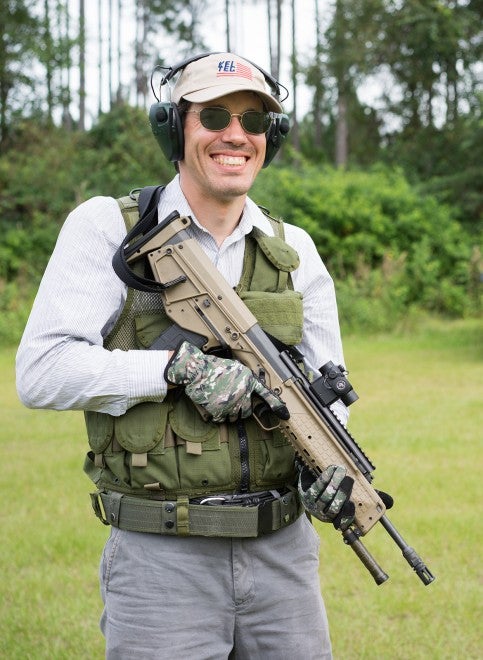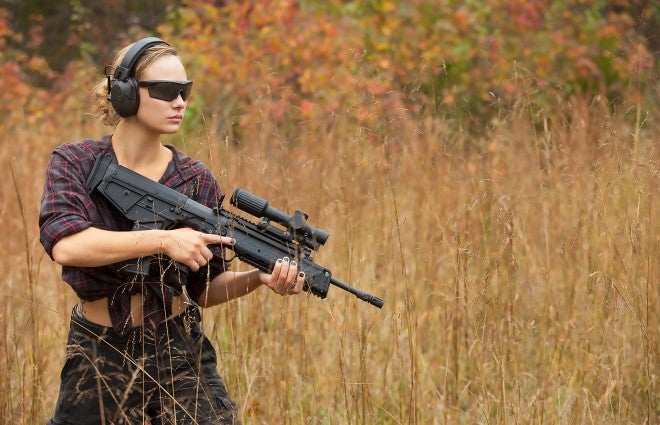Extended Use Report on Kel-Tec RDB
Oleg Volk 11.23.15
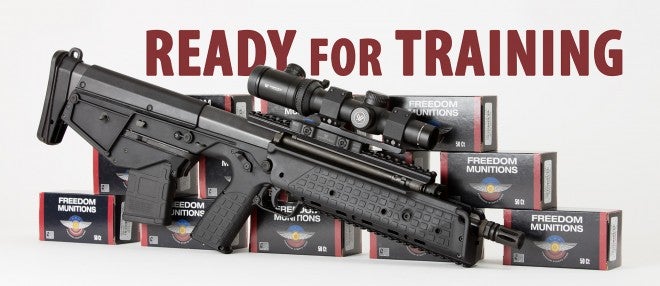
I first got to shoot Kel-Tec RDB in March 2015. After a week in Florida, I took a 17″ and a 20″ rifle to the I.C.E. defensive carbine class Tennessee with me to see how they performed. The course called for 600-800 rounds, I ended up firing a bit more than that.
Since I was visiting Florida for work, I borrowed all guns upon arrival. The rifle above lasted one magazine before the pin holding the extractor sheared off–and that’s when I found out that I grabbed an early prototype by mistake. I finished the first day with a borrowed AR15 and met up with Kel-Tec’s competition shooter Joe Easter to swap RDBs. His rifle was serial number 2, but with all the material upgrades to the production standard. Having had a chance to compare the 17.3″ and 20″ barrels, I am a definite fan of the longer gun. The balance isn’t any different, but the extra velocity is nice to have. The longer barrel also allowed me to push the flashlight further out front. The Kel-Tec weapon light served two purposes: illumination of the target and keeping the hot barrel off my leg when slung. having it pushed far forward gave unoccluded illumination without barrel casting a shadow, as is typical with conventional rifles.
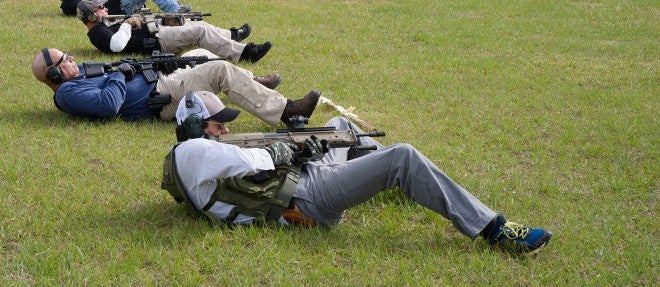
The photo above shows the first major advantage of RDB over most .223 rifles: extremely light recoil. Subjectively, it is much closer to 10-22 levels than to AR15. That allows rapid, accurate fire out of relatively unsteady positions. Again, subjectively, the muzzle rise with an A2 flash hider was similar to an AR15 equipped with a noisy, concussive compensator.
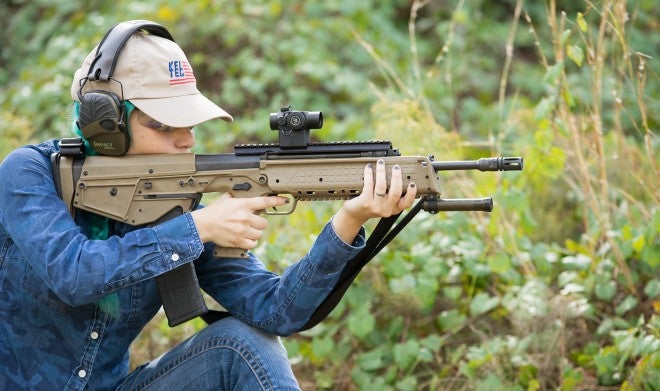
As you can see, the rifle is supported at both ends and thus very easy to aim steadily. Not being a great rifleman, I can still shoot 2MOA from sitting or kneeling using plain 55gr ball. Mechanically, the rifle will shoot 1MOA with ball and closer to 1/2MOA with match 75 to 77 grain handloads, but I am not using it from a rest. The 40-round magazine shown above isn’t convenient prone, but works well for all other positions. RDB ships with a compact 20-rounder, which allows you to get very close to the ground. For my taste, 30-rounders are the best compromise as they hold more ammunition than the shorties and stick out past the grip just enough to be used as monopods.
Prone shooting with RDB requires a fundamentally different technique from most rifles other than FN P90. Rear downward ejection means that the support hand cannot be placed under the buttstock to control elevation. Instead, the magazine becomes the rear monopod, and the arms form the “bipod,” which controls elevation. That hold is extremely steady and can be sustained for a long time. Downward ejection collects brass right by the shooter, same as P90 or MAG58(M240) machine gun, with the attendant risk of burning either the hands of the elbows. Wear long sleeves when shooting this gun prone! Gloves are optional, provided you remember not to push off the pile of fresh, hot brass when rising from prone. On the plus side, the gun doesn’t hurl hot empties rapidly at people next to the shooter or at dividers, all at face level, as regular side ejectors do.
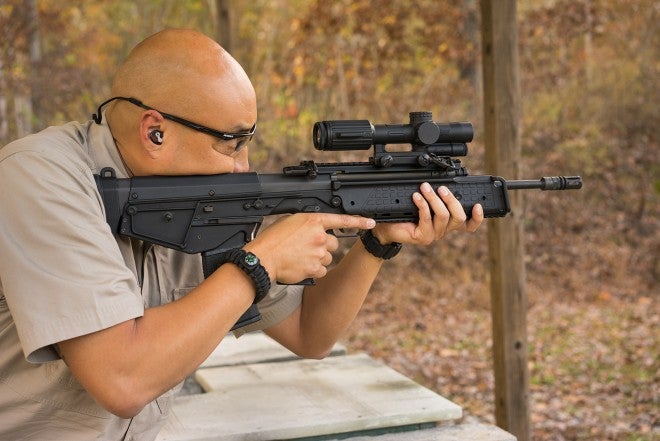
Heat retention turned out to be a non-issue. The weapons heats up similarly to AR15 and can be cooled efficiently by locking the bolt to the rear. All hot parts as well as the gas regulator vent are located away from the shooter’s face and hands.
Loops are built into the handguards and the buttstock for the conventional two point sling. Three additional eyelets are built on each side of the receiver. I found that two point sling works well for deliberate shooting but limits the angles of possible reactive snapshots. My sling kept migrating backward until it approximated a one point. Using the middle eyelet obscured the magazine well during reloads. In general, reloading RDB is very simple: either push the mag catch with the back of the strong hand (not comfortable for me) or reach with the support hand and push the catch to drop the magazine or to retain in. Then rotate the mag well slightly to the left and push a fresh magazine home and either trip the bolt release or run the charging handle. The rifle can remain at the shoulder the whole time and the mag well is positioned more steadily than with conventional rifles. For me, reloading takes about the same time as with AR15.
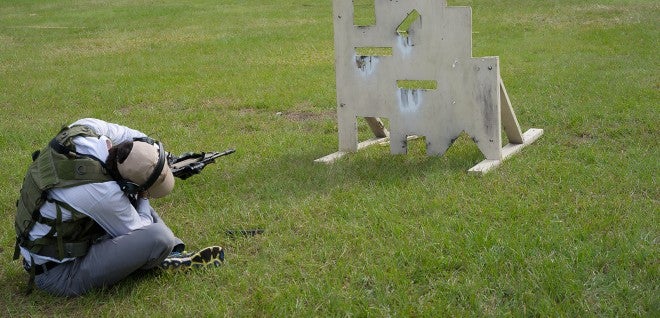
Of all rifles I’ve shot, RDB is by far the easier to shoot from the weak side. I am strongly right side dominant but could run it as effectively from the left as from the right. It can be fired easily on the side as well (for shooting under vehicles or fences), with the empties going to the side instead of up.
Minor complaints about RDB so far:
- I’d like to see the safety lever extended by 1/10″ to provide better purchase with gloved fingers. It works perfectly with bare hands. I found myself pushing on both sides with thumb and forefinger in some positions. It’s not something that ever came up in regular range shooting.
- The mag catch could use a plastic or rubber bumper on it to make releasing it with the back of the strong hand more comfortable. Most RDBs I’ve seen had felt strips added.
- I’d like to see a witness mark (easily added) on the gas regulator to make repeatable settings easier.
That’s about it. I expect that companies like Gearhead Works will offer aftermarket enhancements for RDB very soon.
The advantages are several:
- Excellent accuracy, mechanical and practical
- Decent trigger
- Extra-low recoil
- Relatively short length of pull
- Very quick field-stripping with just two pins
- Very good balance
- Completely ambidextrous controls (charging handle is switchable)
The mechanism is super simple, with fewer parts than an AK47. Dual extractors and considerable bolt over-travel during feeding ensure reliable functioning. I did find one surefire way to make the rifle malfunction: don’t give it enough gas. For example, the borrowed rifle originally had a muzzle brake that I replaced with an A2 flash hider. That reduced the back pressure enough to cause a short cycle. The empty did not extract, instead pushing a fresh cartridge from the magazine forward. The bolt face pushed a third round forward. The solution was to pull the magazine, run the charging handle, and close the gas port a couple of clicks. Once the regulator was set, the rest of the 400+ shots of the day went without a hitch. It’s the only type of malfunction I’ve ever seen in an RDB and one that won’t happen in a gun that was actually set up correctly. Adding a suppressor did not require changing the regulator position.
Standard RDB comes with a folding G3 style charging handle. It works well. I also tried non-folding competition handle, and it was a bit faster in use, with the caveat that a tightly adjusted two point sling may potentially interfere. For most purposes, the lower profile folding design makes more sense.
RDB works well even for relatively small shooters. Length of pull is only 13″ compared to Tavor’s 15.75″. In general, the neutral to slight rear balance of bullpups makes them easier to handle without applying much strength. I wonder if the adoption of bullpups by many European countries, Israel, China, and Australia had something to do with the increased number of women in their armies.
In sum, RDB is easy to shoot well, is fun to shoot, and seems to hold up to extended use. Kel-Tec shooting team has logged tens of thousands of rounds on every one of their guns. I am looking forward to the development of a manual of arms specific to this weapon.
